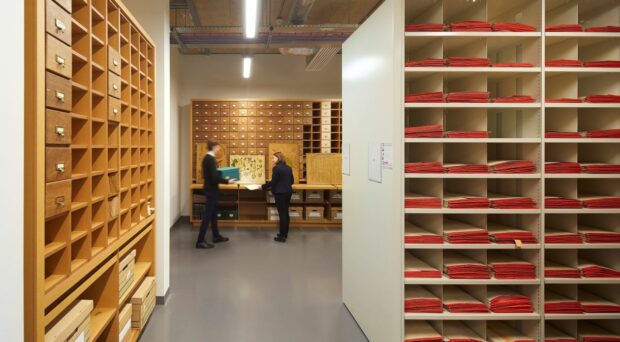Titus is the Botanic Garden’s titan arum plant, sometimes known as the corpse flower. It flowers only once a decade, and the resulting smell has been described as ‘dead badger’; ‘cheesy death’; ‘residue from microwaved kipper’ and ‘the time the freezer died at the Museum of Zoology’. Naturally, Team UCM was there to stream last month’s flowering experience live from Facebook.
This was the fourth in a series of Facebook Live videos produced by the University of Cambridge Museums team, and you can read Rich White’s thoughts at the start of the series here. But in many ways it was a first. It was a first for me as a newbie behind the camera to see how the process worked. It was a first for Rich to be in front of the camera. And it was a first for us to try and capture some breaking news…
When was Titus going to flower?
Turns out corpse flowers take their time. Although the experts at the Botanic Garden knew that Titus was getting ready to flower, and had tipped us off, we didn’t know when the precise moment would arrive. It made scheduling our usual presenter Nick Oram impossible. Rich prepared, nervously, to step into the limelight. (The first item in his notes was “RICH”, in case he forgot his name.)
The Titus phenomenon
Public interest in Titus was huge. When the plant flowered, the Garden arranged special late openings so that visitors could experience the unique pong first hand. BBC Gardener’s World were coming to film a segment. Titus’ popularity made us hopeful that our livestream would find a large audience.
We arrived at the Botanic Garden early in the morning and crept through the glasshouses. Titus’s sickly stench was lingering in the air. The Garden staff had worked the late opening, and though they were tired their passion and excitement was infectious. As the smell grew stronger we spotted Glasshouse Supervisor Alex Summers knelt down in front of Titus. We’d appeared at a crucial moment. Alex needed to collect all the pollen, so it could be sent to other Botanic Gardens. It was careful, delicate work and fascinating to watch. The smell was incredible: not as strong now as when Titus had just flowered, but still powerful. For me, it was definitely eau de PE kit.
Filming the plant
Setting up the camera in the tight space was a challenge – especially as the glasshouse team needed to water the plants around us. But soon we were streaming live. ‘Likes’ appear on the Facebook interface as thumbs up, and they blossomed across the screen. As Alex and Rich talked about Titus, I could see the number of viewers rise and suddenly spike: the Botanic Garden Facebook page had shared us; and then the University page. Throughout the stream, our audience barely dipped below the several hundreds – the equivalent of a large lecture hall – and Alex was able to answer a large number of their questions as I called them out.
Livestreaming: a powerful tool
To date, the video has received 15,000 views. Not bad for half an hour’s work. For me as a newbie, it was striking how simple, and how powerful, a tool livestreaming is. With just a phone, a tripod and an app we’d been able to include followers from all over the world in this very rare moment. Perhaps most excitingly, we’d enabled them to put their questions directly to the expert, giving them some control over the experience. For sure, it was improvised (and some of my camerawork was pretty dodgy) but that’s its charm. It enabled us to beat the BBC’s traditional coverage by several weeks. And who knows, perhaps a glittering TV career for Rich awaits…
Here’s the Facebook video, with comments and likes included:
And here’s the YouTube version:
Like the University of Cambridge Museums Facebook page to see our latest streams from behind the scenes.







